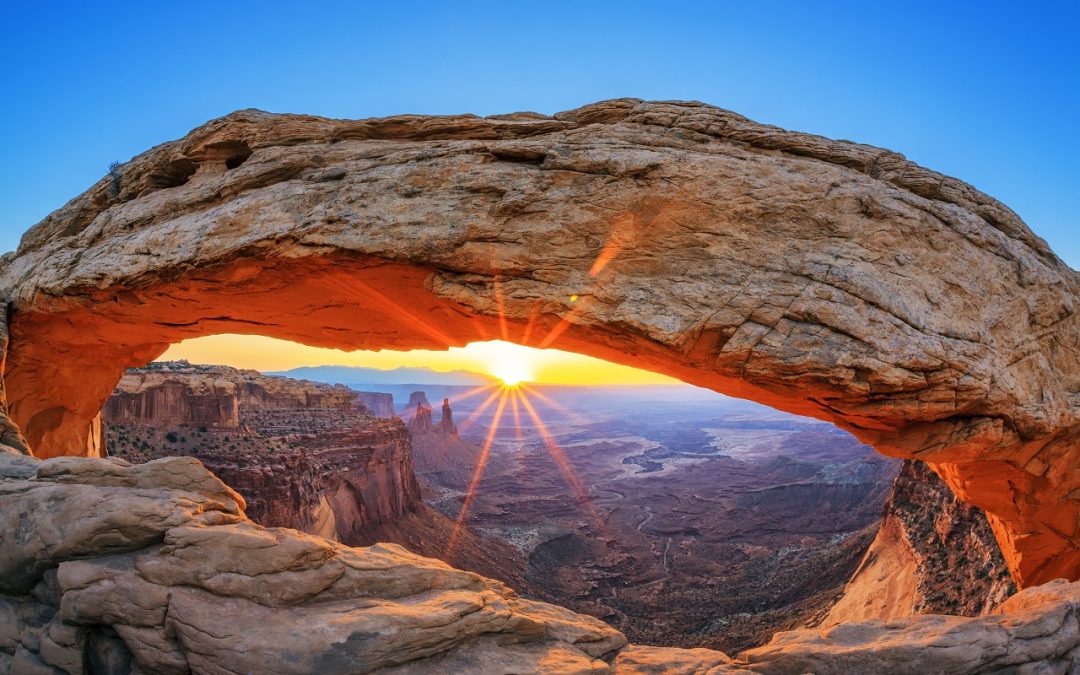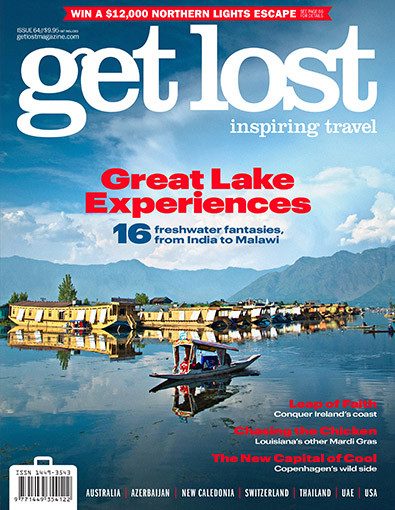With plenty of big sky, big mountains, and big, beautiful rocks spread out over a seemingly endless plain, it’s no wonder why Utah is considered one of the last great unspoiled treasures of the west.
And for the adventure-tourist looking for a totally unique natural experience, it’s an absolute must.
The fantastic thing about Utah, is the sheer number of drive-able National Parks packed into a relatively small area of the state. The so-called “Mighty Five” National Parks in Utah feature a variety of distinctive sure to leave the visitor with a lasting sense of awe and respect for the power of the elements on the earth given enough time.
Although it we suspect it would take years to get an expansive idea of what these parks offer, we distilled the experiences in the absolute must-do’s for each park.
NOTE: As adventure-themed travel advisors, our recommendations are more geared to the “get-up and go type”. While none of the recommendations are super strenuous, there is some recommendations of hikes with some elevation. Also keep in mind that you’re in a high-desert, so dehydration is a real risk – even in cold weather!
Zion National Park
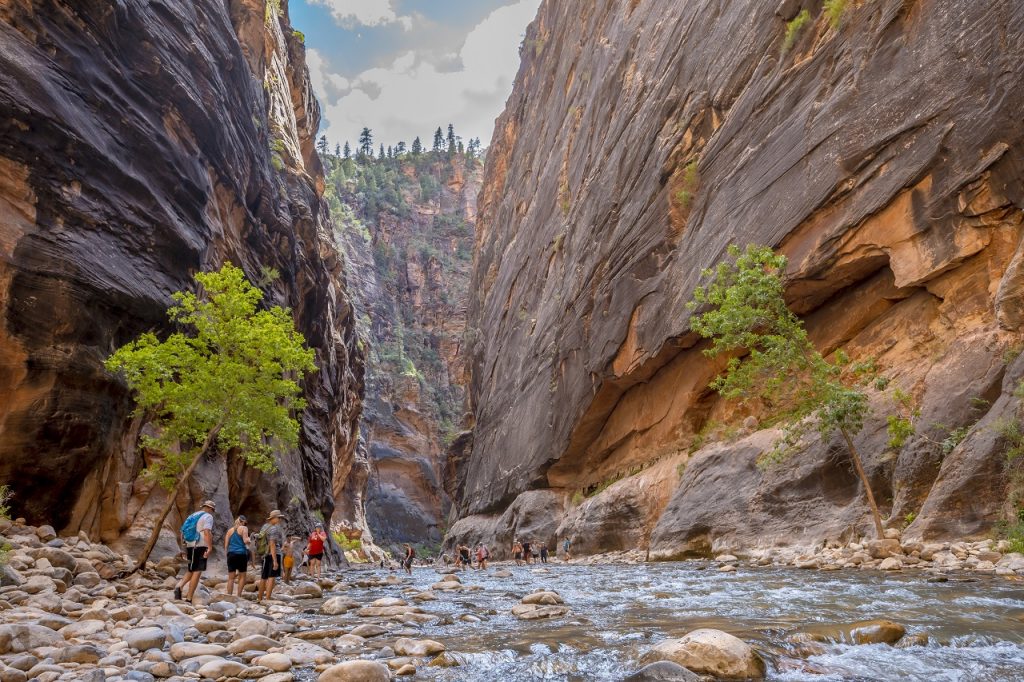
Interior river trail at Zion National Park
At 229 square miles, it may be the smallest of the 5, but Zion National Park is the most popular, packing a wonderful variety of ecological variety in it’s borders. From iconic red rock formations, ancient pinyon pine forests, scenic gorges, to unbelievable views throughout, there’s plenty to do and see.
The One Must Do:
Aptly named, the Narrows are the slimmest section of Zion Canyon in Zion National Park. Situated on the North Fork of the Virgin River and upstream of the main canyon, The Narrows is one of the premier hikes in the park and on the Colorado Plateau. The Narrows refers to both the 3.6-mile (5.8 km) bottom-up hike from the Temple of Sinawava to Big Springs, as well as the 16-mile (26 km) top-down hike from Chamberlain’s Ranch back to the Temple of Sinawava.
The most popular trail in the park, be prepared to hike in water for most of your time, which can be quite cold in the fall-winter-early spring months. As such wear lighter day-hiking shoes, and be sure to bring a jacket as much of the raven gets cold, even during the summer months.
Arches National Park
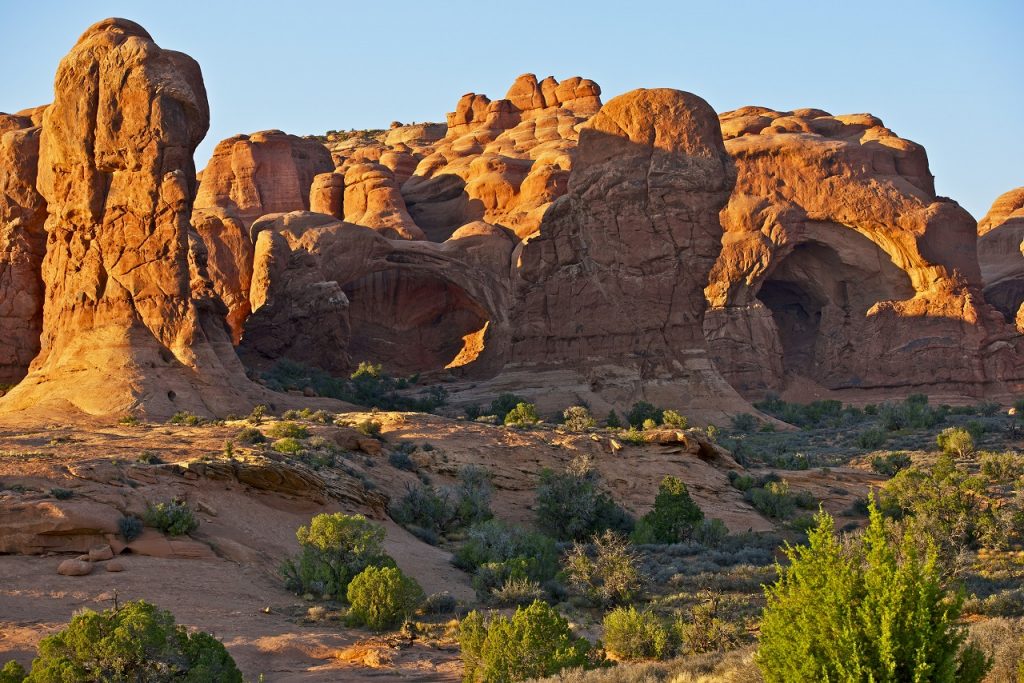
Eroded Red Sandstone Arches at Arches National Park
Deriving its name from the beautiful natural sandstone arches that surround it on all its borders, this Arches National Park offers possibly the best photography opportunities, with countless vistas framed by over 2,000 stone arches of all shape and sizes. In addition to awe-inspiring vistas, Arches National Park offers amazing outdoor activities as well.
The One Must Do:
Views, views, and MORE VIEWS! And topping the list of the many breath-taking views is the world famous Delicate Arch.
People come from all over the world to visit Arches National Park, and we recommend putting Delicate Arch on the top of your to-do lists. This rare free-standing arch has become a widely recognized symbol of the state of Utah and one of the most famous geologic features in the world. The largest free standing arch in the park, it looks as if it has been expertly chiseled from the red clay stone and features a gorgeous backdrop of the
It’s difficult to see Delicate Arch from the main park road; you must get out of the car to view it. At Lower Delicate Arch Viewpoint, you can walk a level 100 yards (91 m) to see the arch from one mile away. Nearby, the Upper Viewpoint (0.5 mi / 0.8 km walk with stairs) offers a slightly less obstructed view.
The trail to see Delicate Arch up close and personal is 3 miles (4.8 km) round-trip and climbs 480 feet (146m). Along this steadily uphill trail, you’ll also pass the Wolfe Ranch cabin and a wall of Ute Indian petroglyphs.
Bryce Canyon National Park
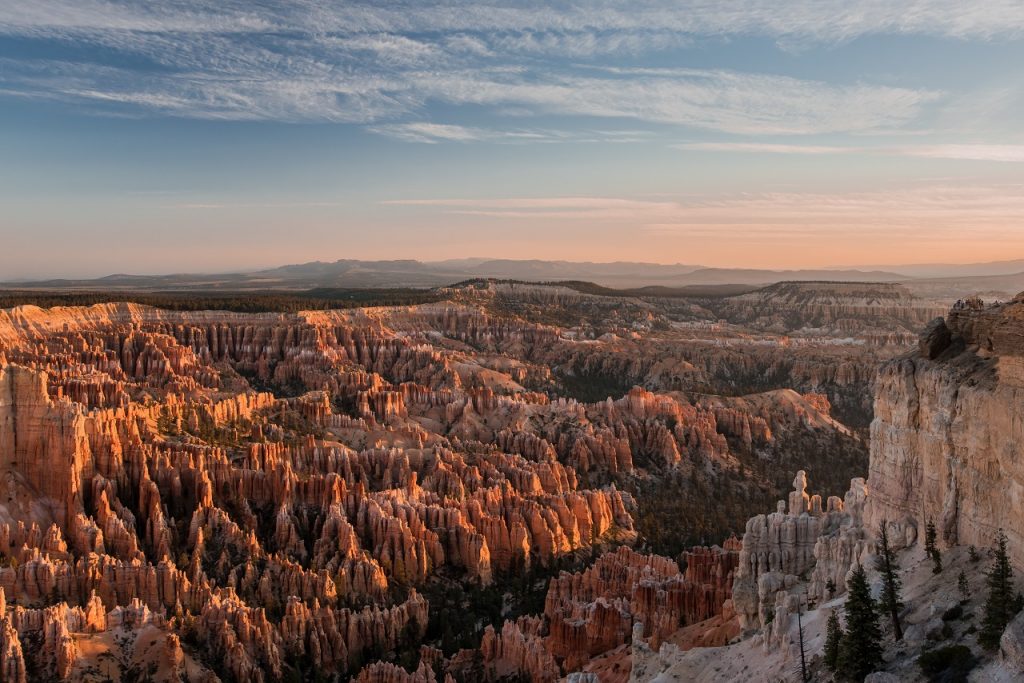
Ridge View of Bryce Canyon, USA
Featuring unique sandstone “hoodoos” (rock formations weathered by the elements) that grid the canyon’s red terrain like a stone army, Bryce Canyon is a once-in-a-lifetime landscape that you just have to see with your own eyes to believe. With trails up close and personal to the imposing hoodoos and up to the vistas above it’s another great opportunity for photographers.
The One Must Do:
Hiking is a must here, and to get the best flavor of the area we absolutely love the Tower Bridge Trail – a scenic 3.6 mile moderately trafficked out and back trail, according to alltrails.com. There is a lot of variation in the landscape
Enjoy views of hoodoos and white sandstone. A review said: “Just do it! The whole hike is just beautiful with tons of cool rock formations to explore and take pictures by.”
Canyonlands National Park
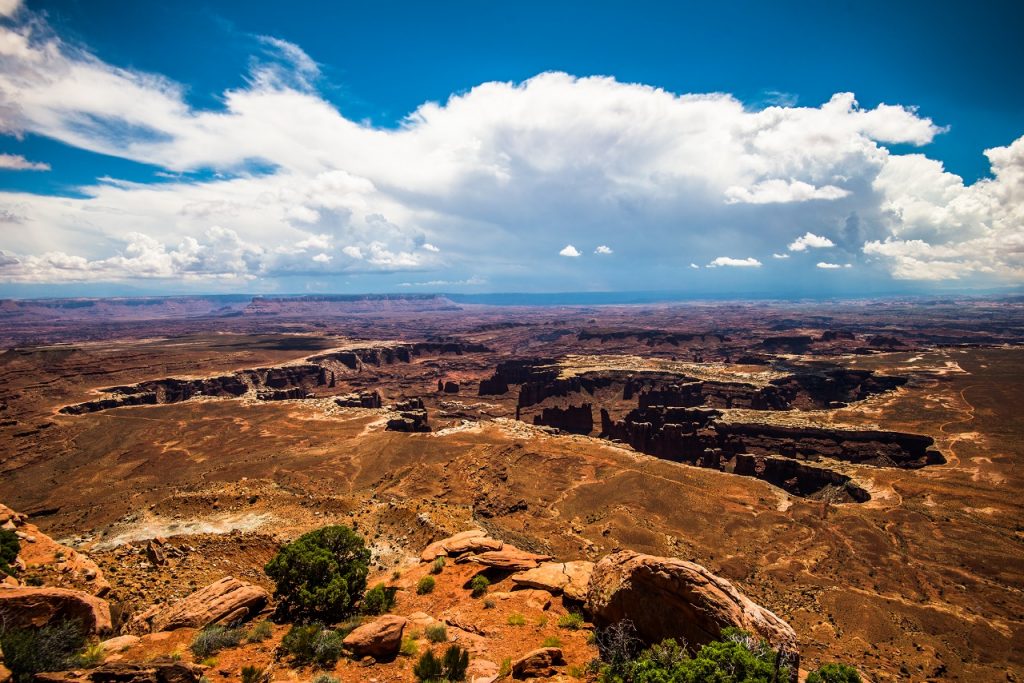
Canyonlands National Park Landscape View
Canyonlands National Park is an immense area in Southeast Utah featuring majestic red rock cliffs, mesas, and – of course – canyons! Shaped by the convergence of the Green and Colorado Rivers this National Park is absolutely huge, and is split into 4 distinct camping districts each with it’s own campgrounds and attractions.
The One Two Must Do’s:
Since this park is so large, it’s impossible to choose just ONE thing to do, so we’ve picked two!
Our first stop is the Island in the Sky district – a stand-alone “mesa”, or flat plateau, shaped like an amoeba that juts commandingly 1800 feet above the surrounding canyon floor below. Located about 35 minutes from Moab, it is accessible by a connecting road called the “Neck”. With sheer cliffs at the edge of the Mesa, you’ve got views for mile at nearly every overlook and hiking opportunity. We recommend taking ½ day drive around the driving loop to take in the many vistas, ending your day in Moab for a bite to eat at our favorite restaurant in Moab the Desert Bistro (https://www.tripadvisor.com/Restaurant_Review-g60724-d403406-Reviews-Desert_Bistro-Moab_Utah.html).
You can’t visit Canyonlands without taking in a sunrise at Mesa Arch. Located a few miles away from the Island in the Sky visitors center, it’s considered one of the most photogenic places in the world to watch a sunrise. As such, you’ll most likely not be alone during this time, so make sure to arrive early to get the best vantage. Even better – come to Mesa Arch during the winter to avoid crowds altogether!
Capital Reef National Park
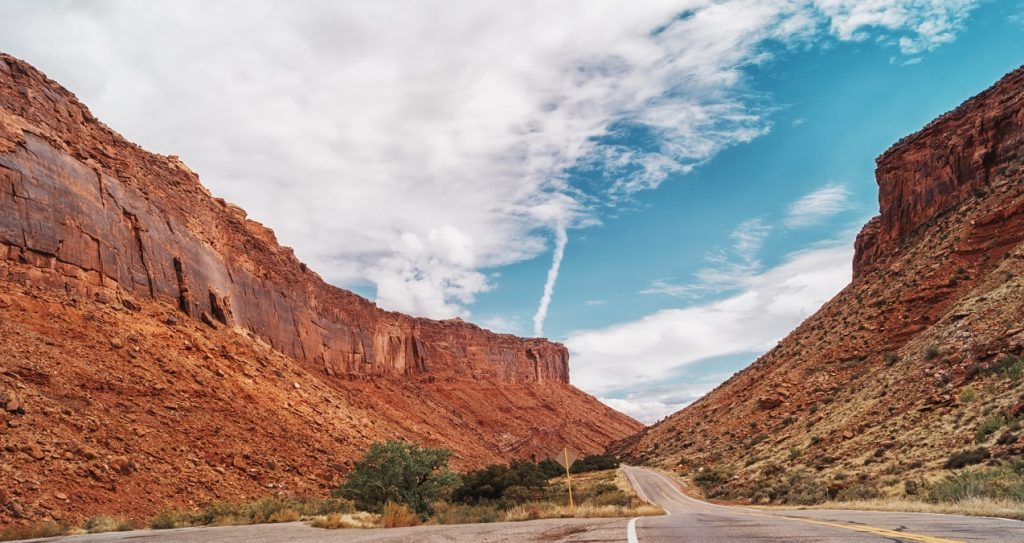
Highway 24 through Waterpocket Fold – Capitol Reef National Park
The Capitol Reef National Park is famous because of its scenic canyons, cliffs, and rock domes. The park hosts the 100+ mile Waterpocket Fold, a totally unique geologic feature which is loved by many hikers and backpack for it’s treasures of hidden cliffs, canyons, domes, and bridges.
The One Must Do:
To get to really get a flavor of this park, you’re going to have to get out of your vehicle and hike! Listed below are our 3 favorites:
| Hickman Bridge | 0.9 mi (1.4 km) |
400 ft (122 m) |
Moderate | 133-foot natural bridge, canyon views |
| Chimney Rock Loop round trip |
3.6 mi (5.9 km) |
590 ft (180 m) |
Strenuous | Panoramas of Waterpocket Fold cliffs, good for sunset |
| Golden Throne | 2.0 mi (3.2 km) |
730 ft (223 m) |
Strenuous | Views of Capitol Gorge and Golden Throne |

